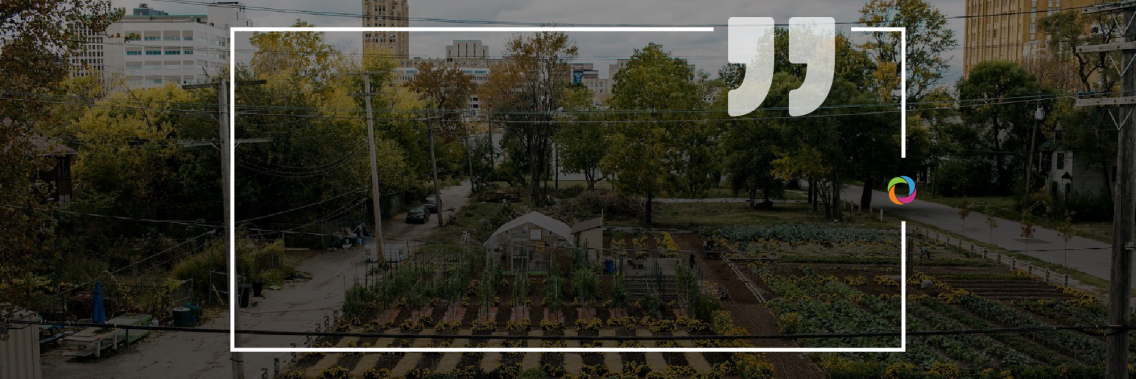COVID-19 has affected almost every area of our lives. One of the most devastating side effects of the pandemic and the associated lockdowns is the impact on the access to food for the poor. Urban agriculture is considered as a strategy that can build resilient urban food systems at the city-region level. Can urban agriculture be a solution to the challenges facing the urban food supply chain amidst COVID-19? Let’s see what agriculture experts say about this.
Can urban agriculture be a solution to the challenges facing the urban food supply chain amidst COVID-19?

“Urban agriculture can be associated with the words “resilience” and “sustainability”. In periods of crisis, due to poverty, unemployment, conflicts or pandemic, food as nourishment remains a fundamental need. To be able to grow our own vegetables can not only reduce the expenses that weigh on family expenditure but can also allow us to face situations when access to market can be difficult or not possible (resilience). In addition, to cultivate more vegetables than are needed for our own consumption can result in a source of income in the case of selling them or in saving money in the case where we exchange our vegetables for others we are not able to produce (sustainability). All this entails not only economic (savings, earnings) or social (exchange, relationship) advantages, but also environmental benefits due to the proximity of the place of production and consumption.”

“Although food and essential products were exempted from restrictions, reality proved different and cities experienced a disruption in the supply of food. Needless to say, it was particularly the urban poor who suffered most because of limited financial means and a lack of natural endowments that protect against food shortages. Against this situation, urban agriculture (UA) can be a cost-effective solution to improve their food security for two reasons. Firstly, UA can provide fresh food to the urban poor and help diversify their diets. Secondly, UA can provide income by allowing them to sell surplus production on the market. Furthermore, UA can provide spillover effects to the food supply chain amidst COVID-19. Indeed, by producing food within cities, the food disruption is mitigated and urban dwellers can have access to more food, thereby protecting their food security. Finally, food produced within cities maintains the dynamics along the food chain that keep other related economic agents active in the food processing, storage and distribution sectors.”

“Urban agriculture occurs at a variety of scale from potted plants and fruit trees to large scale projects such as community gardens, multi-acre commercial urban farms and greenhouses. The COVID-19 pandemic resulted in lockdowns and various control measures. The benefits of urban agriculture in the midst of the COVID-19 regulations include the increased health benefits of fresh food for participants and recipients, building skills and education, generating income, enhancing community development and safe spaces to control the spread of the disease, overcoming larger structural drivers, e.g. income, poverty and health disparities.”

“Urban agriculture could be the savior to avoid a food crisis and market inflation. Various types of urban agriculture are kitchen gardening, rooftop gardening, vertical farming, container gardening, urban beekeeping, aquaculture etc. Multiple areas of crops can be cultivated in the minimal available space, right from herbs, vegetables and fruits to aromatic and medicinal plants. Many cities across the world are practicing urban farming and have achieved success in production, marketing and educating people. In India, urban farming is still at the infant stage and has to be given much more importance by both the government and private agencies to popularize and harness the profitability of urban agriculture. Urban agriculture is the best solution to bridge the gap and address the challenge of urban food supply chains with mitigation measures ensuring a sustainable food system in the post crisis-period. Any severe disruption to the supply of perishable commodities like fruits and vegetables, dairy products, fish, etc., having mobilized to meet the increasing demand from extended middle class as well as urban and rural consumers, may create severe damage to all actors in the supply chain.”

“Urban agriculture remains one of the critical approaches to addressing urban poverty and food supply processes within urban spaces. The challenge of urban agriculture has largely been in accessing land for agriculture competing against its use for settlement and physical development and the use of clean, safe and quality water for irrigation. However, in the midst of the COVID-19 pandemic, with its burdens on food production, utilizing urban spaces for production can greatly shore up local level commodity movement and supplies and ultimate reduce the global level supply challenges (border closures, food perishability, increased costs, prolonged deliveries and handling the transfer or spread of COVID-19 across borders of nations).”

“Encouraging urban agriculture appears essential to tackle, in a sustainable way, food shortage and malnutrition in crisis events. COVID-19 has revealed how serious the fragility of city households in developing countries is. The truth is, the majority of city dwellers work in the informal sector and live on a day to day basis; the curfews and confinement imposed on cities have caused household revenues to plummet and therefore the price of food transported from long distances is no longer affordable for them. Rethinking city functions has to be paramount for donors, city planners and political decision-makers; emphasis on developmental policies oriented to urban agriculture in order to ensure sustainable and nutritive food production and supply to city dwellers is required. City planning must go beyond the classic thinking that cities are considered as residential places, bases for services and industrial production, and rural areas are for food production. Country planning should dedicate food production to city functions, delimited lands should be ascribed to such activities with priority given to vegetable production and to a certain extent animal raising for food waste recycling.”

“I believe urban agriculture holds promise to increase food availability for millions of families in urban centers by empowering them to grow their own food. With the use of innovative technologies to maximize the use of limited spaces, vegetables can be cultivated in almost every home including on roof-tops and balconies. This would not only provide access to food and nutrition but could serve as an additional source of income for the family. Agro-input dealers could provide packages of fertilizers, vegetable seeds and garden tools to promote vegetable production in urban areas. Additionally, governments and NGOs can incentivize the urban population by subsidizing agro-inputs, providing extensive advisory services on television to ensure the efficient use of water and the responsible use of agro-chemicals and the provision of a readily available market to sell the surplus.”

“The COVID-19 crisis disrupted urban rural linkages due to lockdowns bringing with it food insecurity for the majority of urban dwellers, especially the poor. To build a more resilient food system in urban areas, urban agriculture can be a major bridge to the food gaps experienced as well as offering employment to many who have lost their jobs to the pandemic. The farming can be done on empty plots, sidewalks, backyards, rooftops etc. From farming indigenous vegetables to rearing chickens and keeping dairy goats, the pandemic has revolutionized urban agriculture and many consumers are seen to rely on it for a regular supply of food and therefore it boosts household food security. This has also opened another angle to food safety since most are likely to practice organic farming. Since the first priority for an urban farmer is subsistence, it is likely that what is sold is also safe and organic.”

“Urban agriculture entails agricultural production within and around cities or cosmopolitan areas. Urban agricultural output ranges from staple crops like maize, cassava, plantain and vegetables, including local varieties of tomatoes, peppers, leafy vegetables and the more exotic lettuce, cucumbers, cauliflowers and carrots, to livestock such as cattle, goats, poultry and small ruminants. Global estimates state that about 200 million urban dwellers now participate in urban farming, providing 800 million people with at least some of their food and that between 15 and 20% of the world’s food was produced in urban areas. Several researches have helped in the understanding of urban agriculture in terms of health challenges due to the nature of the water used and the location of such farms and solutions have been offered to overcome the challenges of contamination, to improve productivity and ecological balance and provide access to the organic agriculture niche.”

“Urban agriculture can be a solution to the challenges facing the urban food supply chains amidst COVID-19 but it needs some pre-requisites. Firstly, crops can be grown either on public land owned by the municipality or on private land; individuals or grassroots organizations need to have access to land to grow, for example, vegetables. Secondly, only crops with a short vegetative cycle can be grown such as leafy vegetables because the land area is limited and there is a need to increase the volume of produce available per ha over the year. Thirdly, if urban agriculture is taking place on public land, grassroots organizations need to set up a distribution mechanism for the produce among the organization’s members and to define the contribution of each of them to the supply of water and inputs and labor provision. Fourthly, a supply of vegetable seeds is critical to be able to grow such crops and capacity development is needed to enhance the knowledge of growers regarding crop cycles and seed multiplication. Vegetable production coming from urban agriculture can be either sold because access to market is easy or it can be used for families’ food supply.”

“Urban agriculture can be a solution for food scarcity and nutrition deficiency. The corona pandemic has aggravated food scarcity in urban areas through high pricing due to the gap in supply and demand. At this time of COVID-19, food availability in urban areas has reduced due to the restrictions in movements from one area to another. World food production is mainly carried out by small scale farmers where urban areas fall rather than at a large scale. Urban agriculture would reduce production and transaction costs making food cheaper and more available. Urban farming is not only a means of increasing food supply to urban households but a source of improved nutrition. Accordingly, the future of agriculture is to utilize flat roofs, verandas and pavements to help improved nutrition which will also help fight COVID-19. Urban agriculture is a farming method which has a lot of potential but is yet to be exploited as a means of improving food security.”

“In a context of market shocks that lead to disruption of the food supply chain, limited access to food or limited access to movement of people, urban agriculture can have the potential to improve the resilience of communities. The current coronavirus pandemic with its many restrictions (city lockdowns, limited access to movement) represents one of such shocks. In Western African cities, singularly in the big cities (Abidjan, Accra, Ouagadougou, etc.), food prices have risen. In this context, urban agriculture can strongly contribute to make the food more accessible. However, in these cities, urban agriculture is mostly dominated by vegetable crops and livestock (poultry breeding). These in reality are seen not to be the primary crops needed by the most of the population, especially in the crisis period. Primary crops include bananas, yam, rice (also imported from Asia/USA), cassava. Such type of crop plantation requires spaces, and unfortunately it is not possible in these cities where the land becomes scarce. To face these shocks, in addition to the humanitarian corridors that are necessary between the rural-urban continuum, it will also be essential to think above all about Governments. They have to promote the development of urban agriculture through formal national urban agricultural policies via a regional urban agricultural agenda. For the limited spaces, there can be promoted vertical gardens made from sacks and hydroponics systems using mineral nutrient solutions.”

“We must design, develop, and operationalize sustainable rural and urban food systems while considering the improvements in the food safety, traceability, food security through reducing environmental pollution in terrestrial and aquatic systems, reducing the deforestation and greenhouse gas emissions, increasing the number of trees and forests, greening the environment, and keeping and improving the ecosystem services. Therefore, we must engage all stakeholders within the agriculture and agri-food chain from the farm to the fork to achieve a healthy and sustainable food system. I believe that we must globally enhance the awareness of the people toward the topic of food safety and control and this use must be based on the shared values, beliefs, and norms everywhere. In this context, I advise that we must enhance the agroecology in peri-urban and urban areas through implementing sustainable exploitation of the natural resources, developing the sustainable food systems and shorter supply chains, applying healthy dietary patterns and healthy physical activities, increasing global efforts to ensure the food safety and security, supporting smallholder food producers, and ecosystem services and local biodiversity maintenance and effectively applying One Health approach and using genomics technologies in agriculture, agri-food, health systems, and biodiversity and wildlife conservation worldwide.”

“Prior to Covid-19, some parts of the world were experiencing food poverty occasioned by extreme wealth conditions such as flooding; war or conflict, rural -urban migration, among other factors and Coronavirus has worsened the situation because of locked down in some countries of the world that prevented some economic activities. Faced with the increasing food shortage in different countries of the world particularly in the Urban areas amidst Covid-19, Urban Agriculture has become imperative for most urban dwellers to consider growing of food even in small scale, to supplement or complement food production by rural dwellers. Further, Entrepreneurs should consider food production as a viable business that could become source of livelihood, creation of employment and boosting of food production in the urban areas. In addition, food production by using of modern technology such as tractors will enhance food production, thereby helping to avert food scarcity. Furthermore, food preservation and avoidance of food wastage is another option of preventing food poverty both in urban and rural areas amidst Covid-19. Finally, it is imperative to observe that without food sustainability, there can never be sustainable economic growth and development.”
Check more than 120 job opportunities in the agricultural sector here.

